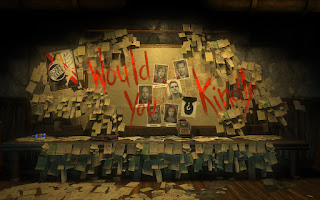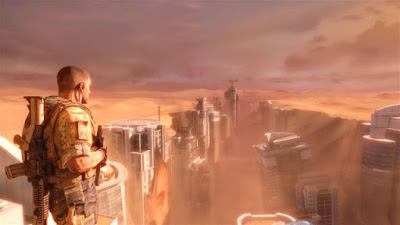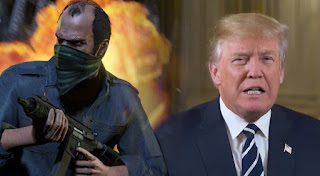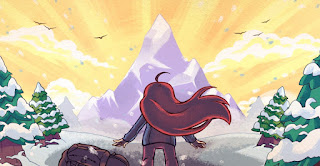The 5 Best Video Game Moments
The 5 Best Video Game Moments
Whether you’re a casual gamer or an almost
obsessive one, it’s impossible to not have an unforgettable moment playing a
game. Whether a game makes you cry, laugh, scream or throw your controller at a
wall, video games have had the power to capture imagination and make incredible
impressions since their earliest days. I haven’t ranked this list in order, but
rather I assigned each spot a category e.g. the most beautiful moment or the
most epic; trying to make a traditional list of best video game moments led to
plot twists and character deaths dominating the list, which is just no fun…so
enjoy.
And obviously a major spoiler alert is due.
1) Let’s start with the infamous plot twists. Of course there’s only
one game that should rightfully own this spot, but first let’s take a look at
some honorable mentions. Braid’s ending
is a jaw-dropping moment that beautifully marries its gameplay and story. The
reveal that you’re the monster the Princess has been running from coupled with
references that your protagonist had something to do with the creation of the
atomic bomb, adds incredible weight to the already heavy-handed themes of
forgiveness and regret. But what makes it truly special is how it
contextualizes everything you’ve been doing within the actual game, reversing
time when you make a mistake in the game is really just an extended metaphor
for the protagonist’s guilt and longing to take back his potentially
apocalyptic actions. Inside’s surprise ending also manages to be simultaneously
fascinating and disgusting. The most surprising video game deaths also deserve
a shout-out, (but more on them later.)
‘Would you kindly?” This line quickly became
legendary since 2007’s seminal Bioshock
for being at the center of the most unexpected reveal in gaming. After
surviving the dystopian, underwater city of Rapture and arriving at the office
of the main antagonist and founder of Rapture, Andrew Ryan, many revelations
unfold. The friendly voice helping you navigate the horrors of the game, Atlas,
is actually the very man who destroyed the utopia of Rapture with civil war,
for his own gain. In fact, you’ve been a pawn in his plan to kill his biggest
rival even before the game started: it’s revealed that the very reason your
plane crashed and you became trapped in Rapture was that Atlas had manipulated
you to crash the plane with the hypnotic trigger, “Would you kindly?” the same
phrase Atlas had been using to push you forward to objectives the entire game.
Ryan knows his death is inevitable and uses the phrase to order you to kill
him, keeping his personal philosophy of “a man chooses, a slave obeys” intact.
It’s a brilliant moment for so many
reasons. It twists the cliché of the voice in your ear in so many shooters. It
raises questions about whether we’re in control in any video game; despite the
fact that gaming’s biggest selling point is its interactivity, and offers a
moment of violent introspection. But Ryan spitting “a man chooses, a slave
obeys” repeatedly while you unwillingly murder him establishes Bioshock as one of the most mature and
interesting games in history, while adding to its political themes of
objectivism and secularism.
2) The number two spot goes to a trope often used in all storytelling
mediums, the best dream sequences. I use the word “dream” loosely here; this
can include anything from actual dreams to drug induced hallucinations, as long
as the moment isn’t actually happening or happening in the way it’s presented,
it qualifies. These are sections I’m especially fond of. They add a
much-appreciated level of surrealism and let the game have fun with itself by
experimenting with mechanics and ideas that would normally be impossible with
the rules established in the game’s world. I could’ve given the number 2 spot to
GTA V, which has plenty of great
ones, including Micheal being drugged by his son leading him to be abducted by
aliens, probed, then thrown out of a UFO where he begins flying through Los
Santos with his numerous dark and hilarious family problems being echoed in the
background. A neat creative moment wrapped up in some twisted family drama. Or
I could’ve even given it to Outlast 2
which constantly switches back and forth between the games rural horror setting
and the hallways of a Catholic school, leading us to question our protagonist’s
sanity and the reality of all the unbelievable events that occur in the game, while
giving us some insight into a childhood trauma.
Despite many stellar options, playing as
the Joker at the end of Batman: Arkham
Knight snatches the number two spot. The Joker has been the highlight of
Rocksteady’s entire Arkham trilogy- and countless other Batman tales- and even
after his death at the end of the previous game, Arkham City, the Joker still manages to be a prominent part at the
end of the trilogy. During the events of Arkham
Knight we learn that Batman had been injected with the Joker’s infected blood,
which included some neuro-toxins that gradually makes its victims adopt Joker’s
mannerisms, eventually almost becoming the Joker. So throughout the game
instead of having the Joker as a physical threat, he becomes a psychological
one, a hallucination wherever Batman goes. Sometimes turning the camera reveals
the Joker just standing there, delivering commentary, and mocking you or others
and generally just being incredibly entertaining. But these hallucinations
crescendo into one of the best moments in all of gaming. After being injected
with Scarecrows fear toxins, Batman’s biggest fear is revealed: becoming the
Joker. The Batman Arkham series’
third-person perspective is replaced with a first-person shooting section,
where the player switches to the Joker as he attempts to take control of
Batman’s mind and body. The section begins with the Joker taking his chaotic
antics to the next level by massacring famous Batman villains the Penguin, the
Riddler and Two-Face along with dozens of their criminal henchmen, quickly
followed by an image of a burning Gotham, the city Bruce Wayne has been
protecting for almost his entire life. This scene soon transitions to a horror
segment as Batman begins to fight back for the control of his mind, playing
with the Joker’s fear of being forgotten. Images of Harley Quinn sobbing at the
Joker’s empty funeral and other similarly pitiful scenes distort their way into
view as Mark Hamill’s unbelievable voice performance as the Joker delivers one
clever one liner after the next. Ultimately Batman wins this mental tug-of-war,
locking the Joker away in his mind as he whimpers one final gut wrenching,
genuine line, “I need you.”
The Joker is arguably the perfect villain;
his devotion to chaos is the mirror opposite to Batman’s unwavering pursuit of
justice and order. Both of their philosophies couldn’t be more at odds with
each other. In the end, what makes this scene so extraordinary is its
fascinating depiction of the relationship between the best superhero/villain
duo in pop culture.
3) Just like the Joker and Batman, violence and video games are
inseparable, so it’s not only appropriate that one of our 10 spots are
dedicated to the best video game deaths, it’s necessary since there’s an
abundance of good ones. The major deaths half way through JRPG legends Final Fantasy 7 and Chrono Trigger are both hugely important and great emotional punches.
While John Marston’s last stand at the end of Red Dead Redemption is arguably just as memorable.
However if you’ve finished the first season
of TellTale’s The Walking Dead Game,
then your mind only thought of one thing the second you read “video game
deaths”. If you played the entirety of that game and weren’t left in tears,
where’s your heart? The Walking Dead
Game’s first season chronicles (soon to be jailed for murder) Lee Everett’s
redemption story as he finds a puppy-eyed, 8-year old girl, Clementine, newly
orphaned at the beginning of a zombie outbreak. The next 8-10 hours tell an
incredibly human story, focused on characters and decisions that are so
grounded they could easily exist in our reality. But in the middle of all the
loss and sadness at the end of the world, is the intimate relationship between
our two leads, Lee and Clementine. As Lee, we teach Clementine how to survive
and shoot a gun; give her haircuts and snacks; talk to her about boys and dads.
Playing as Lee, by the end of the game it’s impossible to not want to protect
this girl. So when Clementine’s been kidnapped and Lee has been bitten, what
results is a race against the clock to save Clem and see her one final time. It
all results in a final 2-minute goodbye scene where eventually Lee can’t even
walk any further by himself due to the infection; he unceremoniously collapses
next to a radiator while the player desperately chooses Lee’s last lines of
dialogue to Clementine. Giving parting advice and saying goodbye feels both
magnificently painful, but also hugely urgent. This is, after all, a
relationship that the players have been invested in just as much as the
characters. This isn’t just Clementine’s goodbye to Lee; it’s the player’s. The
weight of the scene is only elevated by the last shot of Clementine’s face in
tears, staring at Lee’s dying body; she’s alone in this world; Lee’s gone; we
can’t protect her anymore. That realisation sinks in as the credits roll. So
again if you got through that without crying, where’s your heart?
4) If there’s one thing that games do better then almost any other
medium, it’s being epic. A moment that makes you feel like the ultimate badass,
the coolest thing that’s ever existed, but on a grand, larger than life scale.
Despite epic moments occurring left, right and center in gaming, no series is
more synonymous with the word then Halo.
Being epic is Halo’s bread and
butter. It wasn’t difficult to decide that the number 4 spot should go to Halo,
however it was difficult to choose
which moment from the Halo series to
give it to. Crossing the Mombasa bridge with Halo’s famous tank, the Scorpion, in Halo 2 answers the question: what beats the scorpion? Nothing.
Crash landing on the titular Halo ring in the very first Halo game, looking up
to the sky, expecting to see clouds, only to find a literal ring circling
overhead, is still one of the strangest and most mystifying moments since 2001.
However in terms of sheer ‘epicness’, Halo 3’s very last mission easily takes
the cake. Titled “Halo”, this epic conclusion brings the original trilogy full
circle (get it?!) After setting the Halo ring up to explode, Master Chief and
the Arbiter have only a few minutes to make a quick getaway in Halo’s premiere vehicle Warthog, exactly
the same way Halo:CE closed. This
could’ve easily been, the redundant, but thanks to the improved technical
capabilities of a new console mixed with a sense that this really was the last
stand for humanity, Halo 3’s ending
is an appropriate callback to the first game. Driving through a crumbling Halo
ring is spectacular. Snowy, natural
environments quickly fall apart, revealing the architecture that the Halo rings
are built on. Huge chunks of the floor explode and fall away, pushing your
driving skills to their limits trying not to fall through, while enemy aliens
run and scramble for their lives it’s hard not to feel desperate to get to a
ship. The incredible sight of an exploding Halo ring is only made even more
epic with Marty O’Donell’s mind-blowing guitar score erupting as you make last
second jumps between plummeting platforms. Of course the Master Chief, a.k.a
humanity’s savior, going MIA at the end when his escape ship gets split in two
is a fitting end for one of the most iconic and enigmatic figures in gaming (at
least until he made his return 5 years later.) It’s an unforgettable feat of
heroism and sacrifice, seasoned with one of the best video game scores and
plenty of explosions…doesn’t get more epic than that.
5) The last spot goes to the most beautiful gaming moments, not
visually, but emotionally: a moment in games that makes you feel warm or just
happy that you’ve experienced it. These are moments like reaching the top of
the mountain in Celeste and Journey. The final shot of Inside is just as beautiful as it is
perplexingly disgusting. The final audio log in Gone Home is as bitter sweet as a story can possibly get and comes
close to taking the number 5 spot. However. The
Last of Us’ giraffe scene is the definition of beauty.
As previously stated, this spot wasn’t
decided on the moment’s graphical beauty, but it’s undeniable that TLOU’s photorealism contributed to this
moment’s poignant impact. The Last of Us’
violence and brutality is prominent in its bleak take on post zombie outbreak
America (20 years after the outbreak to be exact.) It’s depiction of violence,
grief and pain is immensely shocking, but only because of the game’s remarkable
sensitivity. Every kill the player carries out has significant weight behind it
thanks to world-class animation that grounds the player into the game’s action
in ways few games can. The entire game’s design engrosses you into the stories’
hopelessness, and it’s this design philosophy that elevates the giraffe scene
to beautiful heights. Our two protagonists Joel and Ellie share a similar
non-biological father-daughter dynamic that Lee and Clementine have from the
number 3 pick, The Walking Dead Season
One. They approach the third act of their journey at their lowest point yet
with Ellie understandably traumatised from some shocking preceding events. What
follows is masterfully put together. After moving through the new overgrown
city that we’ve arrived in, our characters come across a far up ledge. Joel
gets into the same position that he has several times throughout the game,
crouching, waiting to give Ellie a boost up it, however this time Ellie doesn’t
come immediately. She’s distracted and Joel needs to call out to her to get her
attention, she’s clearly not okay. After seeing the ‘boost up the ledge’
animation, Ellie inexplicably runs away, toward something. Chasing her, both us
as players and Joel expect the worst in a game that’s taught us to expect
nothing but the worst, but what we discover are a herd of giraffes. Huge
majestic giraffes. Giraffes roaming a deserted city covered in moss and overgrown
greenery. For a game full of despair, this scene might seem simple but actually
presents a silver lining that nature has reclaimed the world. It’s a symbol of
hope: in a world full of death and destruction this scene is a sight of life
and wonder. It’s just one of the many quite moments in The Last of Us that establish it as a masterpiece.














Comments
Post a Comment